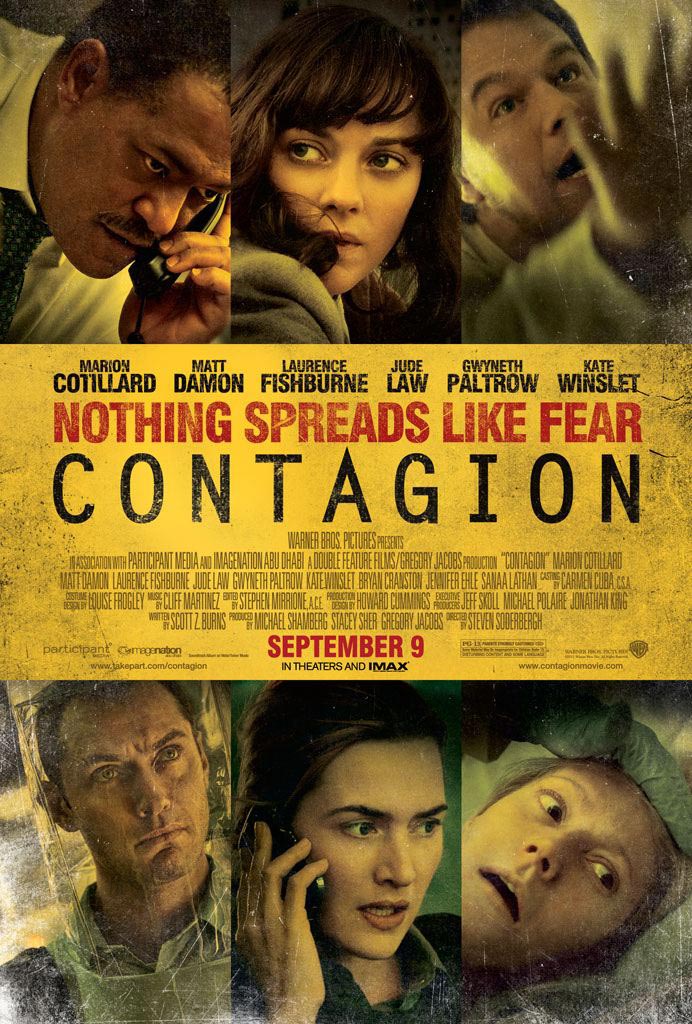
It was a Tuesday night at dinner, and two of my friends and I were discussing what we could do to avoid homework. That’s when one of them said that she had to see “Contagion” for a class, as she was supposed to report on five inaccuracies in the film. So, we decided, what better time than the present? We were looking for an excuse to get away from our studies anyway. So, a few hours later, we were headed to the theatre. I had absolutely no idea what to expect from the movie, but the fact that there were at least five inaccuracies did not help me form a positive impression. But hey, at least we accomplished the goal of evading our homework for the evening. That is, two of us did.
As the title describes, the movie is about the spread of disease. It starts off by depicting the story of the first victim of a new virus, Beth Emhoff (Gwyneth Paltrow). She is on her trip back home when she starts to feel ill. By the time she gets home, she is so sick that there is nothing doctors can do for her. Her husband, Mitch Emhoff (Matt Damon), receives the news of his wife’s passing in a fit of denial and rage. Soon, people in the area start dying at an alarming rate, but Mitch finds himself immune. At this point the CDC starts to get concerned, and we meet Dr. Erin Mears (Kate Winslet), an epidemiologist. She starts tracing the source of the disease by researching how victims are related and travels the country to set up clinics. Despite the efforts of the CDC to contain the disease, the epidemic becomes so serious that millions die in a matter of weeks. People desperately try to find home remedies for the disease, as the development of a vaccine turns out to be trickier than anticipated. The rest of the film follows Mitch, Dr. Mears, and the CDC in the race to stop the devastating virus.
This movie is very pretty to watch. What do I mean by that? I mean that it gets an A+ for cinematography, specifically with camera angles and movement. The movie was able to tell a story just with the filming technique employed. Most movies just film people, and therefore rely on people to tell the story. However, this film relied on people and places to tell the story along with seamless transitions and unique shots of inanimate objects. This technique worked very well with the theme of the movie, as we all know how important inanimate objects are in the story of the spread of disease. The parts where this technique is the most salient is at the beginning and the end of the film.
Storytelling is all well and good, but you must be dying to know what the five inaccuracies were. We actually found six! The first inaccuracy is the film explains that half of your immune system comes from your mother, and the other half comes from your father. This is not true, as genetics have nothing to do with immunity. Your immune system develops by coming into contact with foreign things, such as viruses, and creating antibodies to be employed in future defenses. The second inaccuracy is that the movie leads you to believe that a vaccine will work almost instantly, where in reality it takes about 26 days to incubate in your system before you acquire immunity. The third inaccuracy is that doctors tell Mitch he is immune to the virus before they knew what the virus really was. Therefore, they really had no way of testing for the presence of antibodies against the virus in his system. Fourthly, the incubation time for the virus was 24 hours in the film (to make it more threatening) which is a little too short. It usually takes 7-21 days for a virus to incubate and that’s why viruses are so difficult to detect. People can carry the virus without symptoms for awhile and unintentionally infect others. Fifth, the CDC said that the virus mutated and no one mentioned the need to develop another vaccine against the new strain of the virus. The last inaccuracy was the film employed the term pleomorphic to describe the virus, which is a little strange because this term is usually used to describe bigger cells, such as cells belonging to bacteria.
Now that the inaccuracies are out of the way, and that your inner nerd is satisfied, I have one more thing to give you a heads up about: you will wash your hands excessively for a few days after watching this movie, and will probably slightly panic if you sneeze or get a sore throat. This movie is like watching the journey of a tiny spec of paint as it grows and transforms into an unbelievable masterpiece.
By WhiteChick
No comments:
Post a Comment